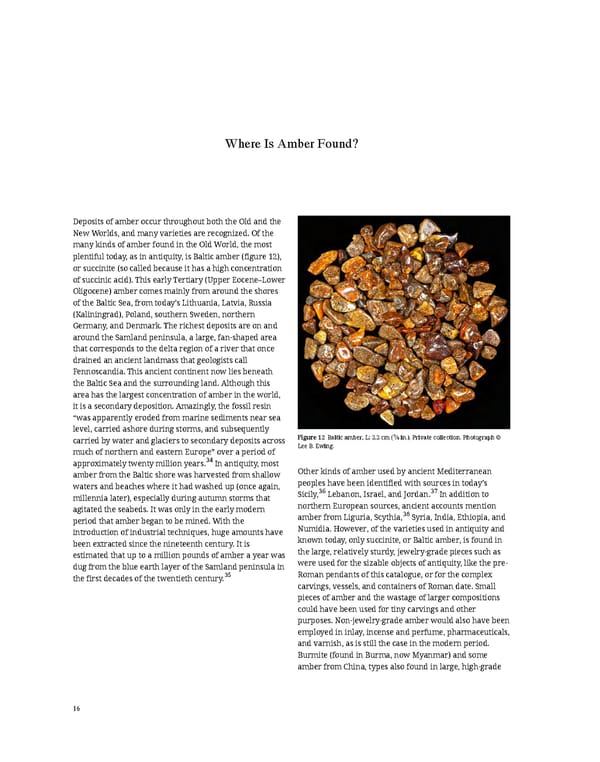Where Is Amber Found? Deposits of amber occur throughout both the Old and the New Worlds, and many varieties are recognized. Of the many kinds of amber found in the Old World, the most plentiful today, as in antiquity, is Baltic amber (figure 12), or succinite (so called because it has a high concentration of succinic acid). This early Tertiary (Upper Eocene–Lower Oligocene) amber comes mainly from around the shores of the Baltic Sea, from today’s Lithuania, Latvia, Russia (Kaliningrad), Poland, southern Sweden, northern Germany, and Denmark. The richest deposits are on and around the Samland peninsula, a large, fan-shaped area that corresponds to the delta region of a river that once drained an ancient landmass that geologists call Fennoscandia. This ancient continent now lies beneath the Baltic Sea and the surrounding land. Although this area has the largest concentration of amber in the world, it is a secondary deposition. Amazingly, the fossil resin “was apparently eroded from marine sediments near sea level, carried ashore during storms, and subsequently carried by water and glaciers to secondary deposits across Figure 12 Baltic amber, L: 2.2 cm (7⁄8 in.). Private collection. Photograph © much of northern and eastern Europe” over a period of Lee B. Ewing. approximately twenty million years.34 In antiquity, most amber from the Baltic shore was harvested from shallow Other kinds of amber used by ancient Mediterranean waters and beaches where it had washed up (once again, peoples have been identified with sources in today’s Sicily,36 Lebanon, Israel, and Jordan.37 In addition to millennia later), especially during autumn storms that agitated the seabeds. It was only in the early modern northern European sources, ancient accounts mention amber from Liguria, Scythia,38 Syria, India, Ethiopia, and period that amber began to be mined. With the introduction of industrial techniques, huge amounts have Numidia. However, of the varieties used in antiquity and been extracted since the nineteenth century. It is known today, only succinite, or Baltic amber, is found in estimated that up to a million pounds of amber a year was the large, relatively sturdy, jewelry-grade pieces such as dug from the blue earth layer of the Samland peninsula in were used for the sizable objects of antiquity, like the pre- the first decades of the twentieth century.35 Roman pendants of this catalogue, or for the complex carvings, vessels, and containers of Roman date. Small pieces of amber and the wastage of larger compositions could have been used for tiny carvings and other purposes. Non-jewelry-grade amber would also have been employed in inlay, incense and perfume, pharmaceuticals, and varnish, as is still the case in the modern period. Burmite (found in Burma, now Myanmar) and some amber from China, types also found in large, high-grade 16
 Ancient Carved Ambers in the J. Paul Getty Museum Page 25 Page 27
Ancient Carved Ambers in the J. Paul Getty Museum Page 25 Page 27